The Google Pixel C Review
by Brandon Chester & Joshua Ho on January 25, 2016 8:00 AM ESTSystem Performance
One of the highlights of the Pixel C is the fact that it is powered by NVIDIA's Tegra X1 SoC. This technically isn't the first time that X1 has shown up in an Android device since it powers the SHIELD Android TV, but it's the first time it has been used in a mobile device. This implementation of Tegra X1 has four Cortex A57 cores with a peak frequency of 1.91GHz, along with four Cortex A53 cores. There are a few things that need to be mentioned about how Tegra X1 differs from other SoCs with eight cores. The first is the fact that in theory, Tegra X1 uses cluster migration rather than Heterogeneous Multi-processing. The reason I said in theory is because the implementation in the Pixel C is really only using the A57 cluster and scaling the frequency as low as 51MHz and as high as 1.91GHz.
In any case, all of our benchmarks should trigger the A57 cores in a mobile device that pairs A53 and A57 cores, so the discussion of the A53 cores being disabled is more relevant from a power consumption standpoint than a performance one. To analyze the general performance of the Pixel C I've run it through our standard JavaScript tests, along with PCMark and BaseMark OS II.
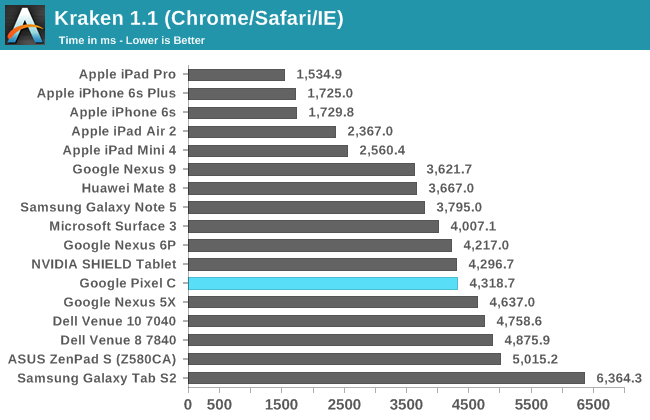
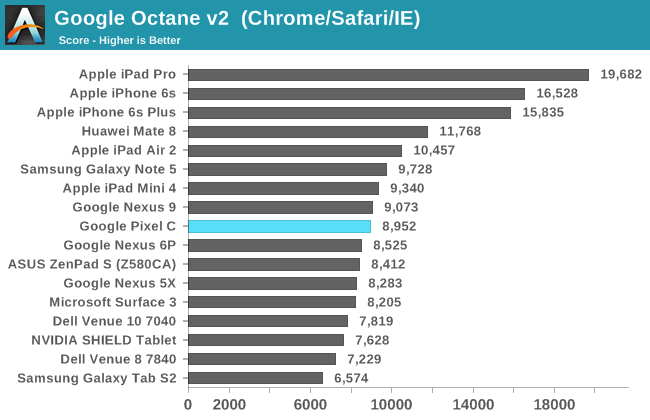

Unfortunately, the Pixel C doesn't make a very strong showing in our JavaScript benchmarks. I can't help but feel that this is the result of a rushed Android build, as there are regressions compared to the Nexus 9 in Octane and Kraken, and in all cases the score just isn't that impressive. JavaScript performance is definitely something Google will have to work on in the future, as the gap between the performance of iOS and Android devices is growing fairly large.

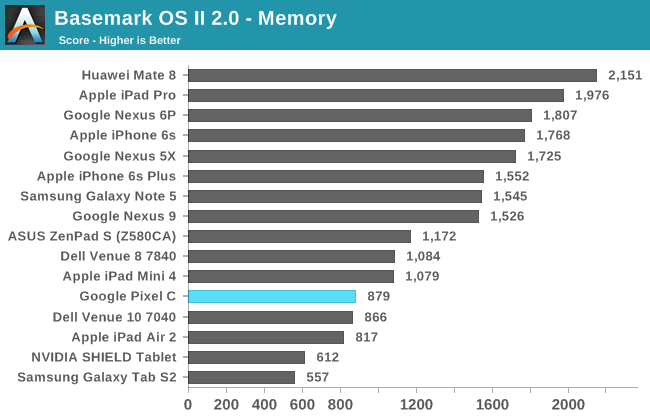
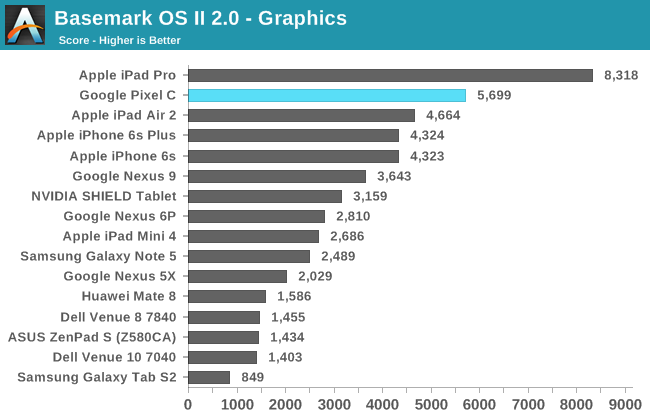


The Pixel C only achieves decent results in BaseMark OS II. The NAND memory score definitely drags down the overall rating, with the web score being lower than expected, and the system score being shocking low. The stand out score is in the graphics test, with the Pixel C only coming second to Apple's iPad Pro, and beating out the next best Android device, which is also NVIDIA-powered, by a huge margin. Unfortunately, high as it may be, Tegra X1's graphics performance just isn't enough to carry the Pixel C here.
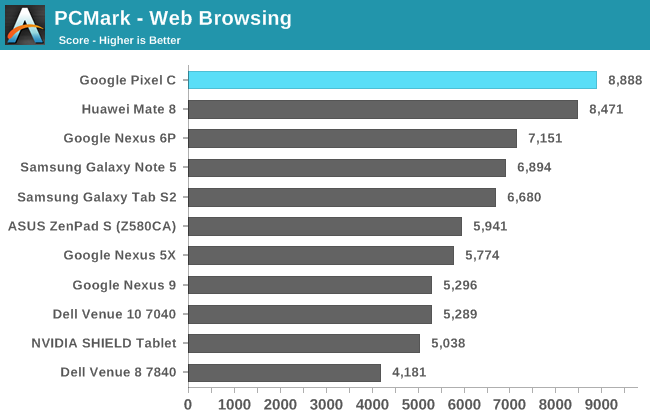
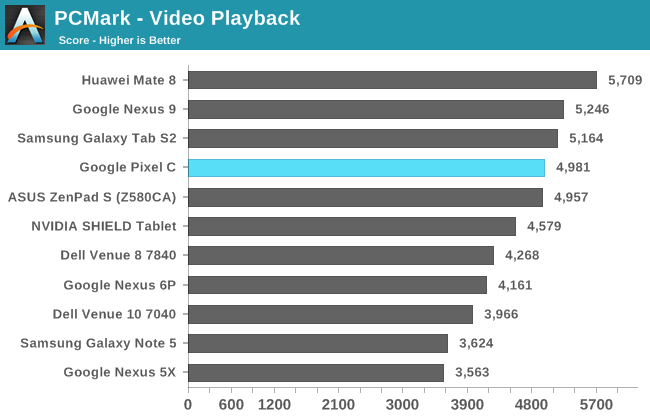

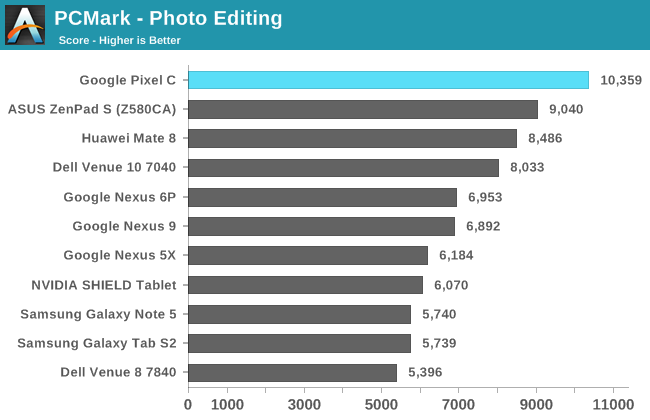
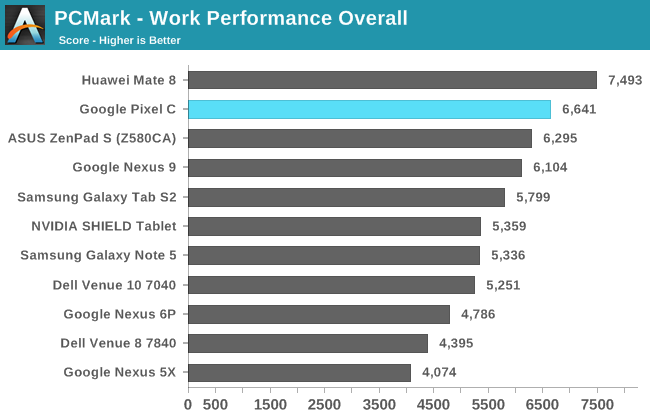
PCMark paints a different picture than BaseMark OS II, and highlights how performance can be highly variable based on workload, software, and whether an app is run as a native binary or through ART. In PCMark the Pixel C performs exceptionally well, with the exception of the writing test which seems to have been impacted by some change made to ART on Google's devices when moving to Marshmallow. Putting that aside, we see quite high and often chart topping scores in the remaining tests, resulting in a final score that only sits below the Huawei Mate 8.
Characterizing the Pixel C's performance is difficult. PCMark paints a very good picture, and I'm tempted to lean toward it as it is representative of the tasks that users will perform on a daily basis. There's a bit more discussion to be had about the Pixel C's general performance, and that'll come a bit later in the software section of the review. What I can say is that Tegra X1 certainly is fast as far as raw speed goes, but there's more to be said about the Pixel C's performance when you consider the role of both hardware and software.










122 Comments
View All Comments
ImSpartacus - Monday, January 25, 2016 - link
How disappointing. I hope the iPad can some day see some actual competition from something other than an x86 tablet.vFunct - Monday, January 25, 2016 - link
Not going to happen. The Google ecosystem is focused on ignorant third-world consumers that think more cores are somehow better than faster individual cores. It's a problem of Google's making, where they have the mistaken belief that targeting the poorer class will somehow make their products superior against those that target the upper-class, like Apple.Apple will reign supreme as long as everybody else has no clue how to market to the upper class.
ImSpartacus - Monday, January 25, 2016 - link
Yeah, Asia's obsession with core count is quite curious.It's particularly depressing that non-apple arm tablets don't take off because it really kneecaps any incentives for anyone to make high performance SoCs with tablet-tier thermal budgets. They have to adapt phone SoCs for that purpose because the tablet market isn't big enough to justify its own SoCs (unless you're Nvidia and you can't make anything smaller). So it means that stuff like the a9x can just sweep the floor and it's only challenged by x86 stuff because that's the only other source of legitimate high performance tablets.
Murloc - Monday, January 25, 2016 - link
In Spain apple has a 9% marketshare.Maybe they're ignorant third-worlders, or maybe it isn't as simple as you say.
Sttm - Monday, January 25, 2016 - link
Spain has almost 50% youth unemployment. As such its not hard to see why their tech preferences favor cheaper hardware originally destined for the 3rd world.But then again if Spain does not start to turn around its employment situation, it will be the 3rd world before too long.
WinterCharm - Tuesday, January 26, 2016 - link
Exactly. You have to look at purchasing power of a nation. Apple markets to the young and wealthy upper class.There's a reason Apple only has 5-6% of the market share. But 90% of profits, and 90% market share in the $1000+ computer category is because they refuse to pander to the lower segments of the market.
If you want the best and you can afford it, you buy Apple gear.
Alexvrb - Wednesday, January 27, 2016 - link
If you want the best, can afford it, and are tech savvy, you get a Surface Pro or similar top-tier device.In the case of the Pixel C, even a "lowly" non-Pro Surface 3 is a better value. Mostly due to the superior Cherry Trail SoC.
Alexvrb - Wednesday, January 27, 2016 - link
Oh, except in 3D graphics. Intel still sucks there on their lower power chips. So I guess if you're buying one to play high-graphics games that would be stupid. But for other tasks Cherry Trail is great, I set one up with a dock for someone that uses it as their tablet and "desktop" PC and general purpose performance, multitasking etc is pretty decent. Even has HEVC hardware decoding support. The NAND is even reasonably fast, has enough RAM and they have the 128GB model plus a USB SSD attached to their dock so storage isn't an issue (has SD slot for easy mobile storage expansion too).ImSpartacus - Wednesday, January 27, 2016 - link
I think he's speaking more broadly about laptops and the whole nine yards.Lolimaster - Tuesday, January 26, 2016 - link
Problem is youre not paying for the best, just bragging rights while getting scammed and locked in their ecosystem, the perfect fool.